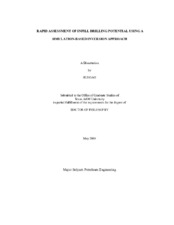| dc.description.abstract | It is often difficult to quantify the drilling and recompletion potential in producing gas fields, due
to large variability in rock quality, well spacing, well completion practices, and the large number
of wells involved. Given the marginal nature of many of these fields, it is often prohibitively
expensive to conduct conventional reservoir characterization and simulation studies to determine
infill potential. There is a need for rapid, cost-efficient technology to evaluate infill potential in
gas reservoirs, particularly tight gas reservoirs. Some authors have used moving window
statistical methods, which are useful screening tools for identifying potential areas or groups of
wells for further study. But the accuracy of the moving window method in very heterogeneous
reservoirs is limited, based on the analysis of some authors.
This study presents a new simulation-based inversion approach for rapid assessment of
infill well potential. It differs from typical simulation inversion applications in that, instead of
focusing on small-scale, high-resolution problems, it focuses on large-scale, coarse-resolution
studies consisting of hundreds or, potentially thousands, of wells. In an initial application, the
method employs well locations, production data, an approximate reservoir description and,
accordingly, is able to identify potential areas or groups of wells for infill development quickly
and inexpensively. Prediction accuracy can be increased commensurate with reservoir
characterization effort, time and costs. Thus, the method provides a consistent basis for transition
from screening studies to conventional reservoir studies.The proposed approach is demonstrated to be more accurate than moving window
statistical methods in synthetic cases, with comparable analysis times and costs. In a bind
validation study of a field case with 40 years of production history, the method was able to
accurately predict performance for a group of 19 infill wells. | en |


